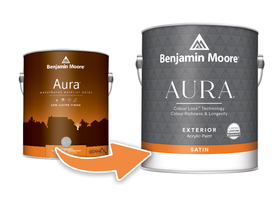
What’s The Difference Between Interior and Exterior Paints?
Different paints have different properties, and are formulated for different purposes. Interior paint is made to be scrubbed, resist staining, and allow cleaning. Exterior paints are made to combat against fading and mildew. When starting a painting project, it’s important to know the differences between the two and choose the right paint.
In order to understand the difference between exterior and interior paints, you will need to learn a bit about the chemistry behind paint. Read on for an introduction to the main components of all paints.
First, some basics about paint
The components of all paints contain pigments, solvents, additives and resins. In latex paint, the solvent is water, while in oil-based paint the solvent of choice is mineral spirits. The solvent is what causes the paint to be ‘wet’. As paint dries, the solvent will evaporate. You are left with the resins, pigments, and additives, which are the lasting ingredients. The pigment is the color, which is bound to the surface by the resin. Resins can be made of epoxy, acrylic or even silicone.
Additives give paint different properties, such as resisting the growth of mildew, making the paint easier to apply, or even making it easier to clean.
In both types (interior and exterior) the solvents and pigments share similarities. You can use either oil-based or water-based paints outdoors, but for interior work oil-based paints are not usually used. The reason is their odor and difficulty to clean-up.
So, what’s the difference?
While there can be many subtle differences, the primary difference between interior and exterior paints is in their choice of resin. You will remember that the resin is what binds the pigment to the surface. In an exterior paint, it is important that the paint can survive temperature changes and being exposed to moisture. Exterior paint also must be tougher and resist peeling, chipping, and fading from sunlight. For these reasons, the resins used in binding exterior paints must be softer.
For interior paint where temperature is not a problem, the binding resins are more rigid, which cuts down on scuffing and smearing.
Where should you use one over the other?
The added resins in exterior paint can cause outgassing, that may last up to 48 hours, but usually continues in small amounts for years. This is one reason you wouldn’t want to use exterior paint indoors. Choose a flat sheen exterior paint for masonry and stucco, as this will allow the surfaces to breathe, and allow moisture to breathe through the paint to escape. Brick walls especially should be allowed to breathe, as moisture transfer is to be expected with brick.
Interior paints are delicate in comparison with exterior paints, but don’t outgas in the same way, making them safer to use indoors. You should still make sure there is adequate ventilation when painting indoors. For an indoor surface, you may need to clean and scrub, choose a glossy finish interior paint, as they resist scrubbing better than flat surfaces, which can smear.
As a final note, we should mention that there are paints that are both interior and exterior, and can serve either purpose. These paints can be quite useful and versatile, but do have some tradeoffs. When in doubt about what type of paint to use, talk to a professional painter, or come into our paint store and ask our highly knowledgeable staff.



